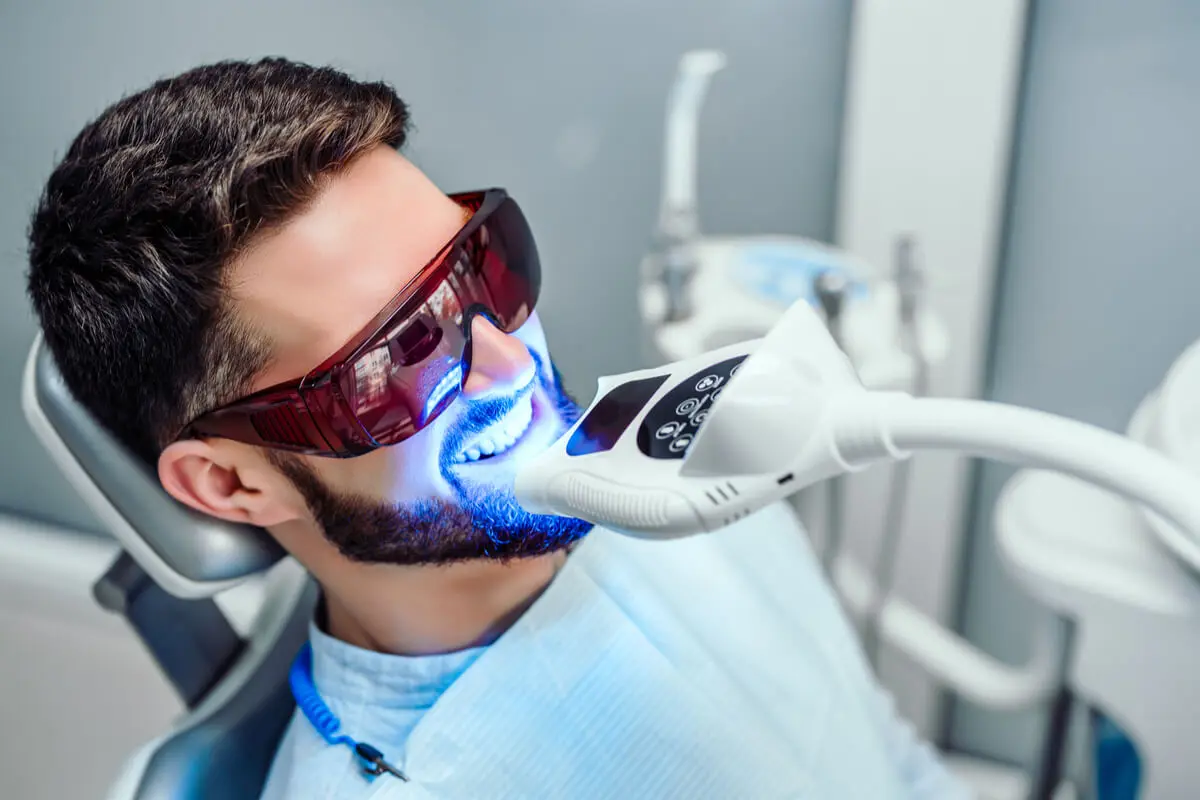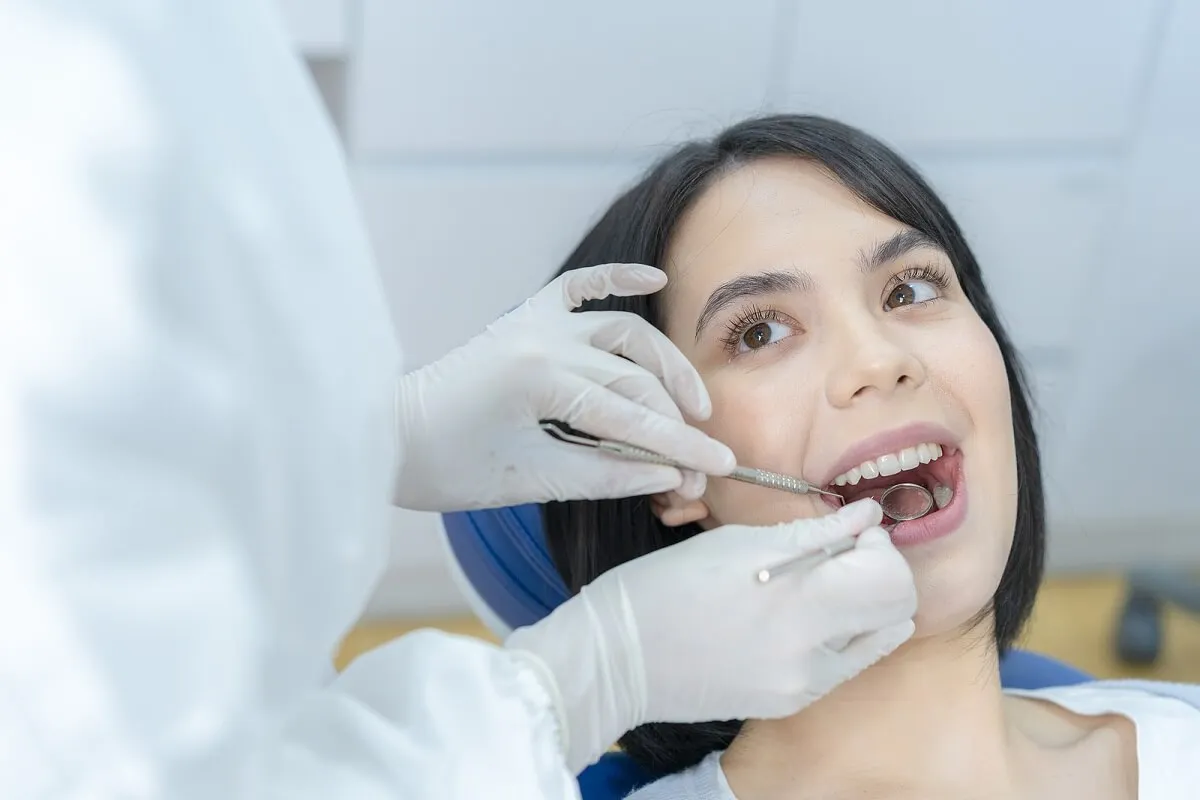5 Tips to Take Care of Your Teeth Whitening


Written and verified by the dentist Vanesa Evangelina Buffa
The passage of time, diet, neglecting hygiene, and certain habits such as smoking can all stain the teeth. To counteract these effects and show off a more beautiful smile, teeth whitening is an increasingly used alternative. However, it’s crucial that it’s done correctly.
These procedures are often performed professionally at the dentist’s office or at home, under the supervision of the dentist. However, there are also home methods and natural remedies that seek to lighten the teeth.
The truth is that, once the desired appearance is achieved, the results won’t last forever. To keep your teeth looking white and shiny, you’ll need to take care of them. Keep reading to learn all about how to do this.
What is teeth whitening?
Teeth whitening is a procedure used to lighten various shades of the color of the teeth. Thus, the teeth look whiter, brighter, and cleaner and the smile acquires a youthful and healthy appearance.
This is a useful treatment to improve the appearance of stained and discolored teeth. It’s also a cosmetic alternative for those who seek to improve the appearance of their mouth.
The procedure consists of placing certain chemical substances on the tooth surfaces and leaving them to act for a reasonable period of time. The most commonly used are carbamide peroxide and hydrogen peroxide. They’re used in different concentrations depending on the method of application.
Special splints designed for each patient are used to deliver the product to the mouth. This prevents the product from damaging the soft tissues of the oral cavity.
It’s essential that before undergoing this treatment, the dentist verifies that your mouth is in optimal conditions. In case the patient has cavities, gingivitis, fractures, fissures, or any other oral pathology, they should be treated and solved beforehand.
When done in a professional environment, the results are evident in a very short time. On the other hand, home methods are usually not as effective and fast, but can also be risky for oral health.
Before taking a look at how to take care of your teeth whitening, we’ll tell you more about the options for this type of treatment.

Types of teeth whitening
As we’ve already mentioned, there are several techniques and ways to lighten the teeth. Depending on the method chosen, the results obtained, the duration of the treatment, and the waiting time to observe the changes vary. Specifically, they can be classified into the following four groups.
Teeth whitening at the dentist’s office
This treatment is performed by a dentist at their office. The professional cleans the teeth, protects the gums, and then places a whitening gel on the surfaces of the teeth.
It’s left to act and sometimes activated with a special light. Two sessions may be necessary, although changes may already be evident in the first one.
Outpatient teeth whitening
The dentist performs a dental cleaning and makes a customized splint for the patient’s mouth. Then, at home, the person uses this tray to place the whitening gel provided by the professional.
He/she puts it in their mouth and leaves it to act for the time indicated by the dentist. Then, they repeat the process on the days also specified by the specialist. In general, it’s usually 3 hours per day for a week, although it varies according to the product used.
Sometimes, this treatment is combined with dental whitening in the dental office. The person performs the technique at home, then the dentist does an in-chair session, and finally, the patient repeats a few more applications at home.
Home methods
At-home teeth whitening products can be found in pharmacies and supermarkets. Special kinds of toothpaste, oral rinses, whitening strips, and even tooth painting pens are the options available.
These methods are not as effective and the results take a long time to be noticed. In addition, there’s a risk of damaging oral tissues if not used properly.
Homemade and natural recipes
The application of homemade formulas and recipes for teeth whitening are discouraged. Often, they suggest the use of abrasive (baking soda, clay, activated charcoal) or acidic (citrus juices, strawberries, or vinegar) substances that actually damage the tooth enamel.
How long does teeth whitening last?
Once teeth whitening has been performed and the desired bright smile has been achieved, many patients wonder how long the results will last. This really depends on the procedure chosen and the aftercare.
Professional treatments, both in-office and at-home, are the longest lasting. In very careful patients, the effects can last from 1 to 3 years.
Home and over-the-counter methods, on the other hand, achieve more subtle lightening and do not last long. This can lead people to overuse them and end up damaging their teeth.
And as we said, the use of natural abrasives or acids wears away the enamel. This leaves the underlying dentin exposed, resulting in yellowing of the teeth. Therefore, the result is usually not as expected, and in this case, the loss of dental tissue is irreversible.
However, beyond the chosen technique, the persistence of the bright smile also depends a lot on the person’s subsequent behaviors. How you take care of your teeth whitening will depend on how long the whitened appearance will last.
The best tips to take care of your teeth whitening
After teeth whitening, the dentist will explain to the patient the aftercare and how to maintain the result. Following these instructions is essential to maintain the beautiful smile that has been achieved. So, what should you keep in mind?
We think you may be interested in reading this, too: 5 Home Remedies to Remove Plaque From Your Teeth
1. Maintain proper oral hygiene
Not neglecting oral hygiene is a fundamental step to maintaining the white effect on the teeth. If the cleaning of the mouth is not adequate or sufficient, bacterial plaque, tartar, and stains will darken the teeth again.
Therefore, to keep your mouth clean, you should brush your teeth for at least 2 minutes after every meal. Or, you should do this at least 3 times a day. Care should be taken to perform the correct technique and use an instrument with soft bristles that don’t injure the gums.
In addition, it’s necessary to use a fluoride toothpaste to reduce the sensitivity that sometimes appears after these treatments. Flossing once a day completes the cleaning, as it removes bacteria and food debris trapped between the teeth.
If your dentist recommends it, your cleaning routine can be completed with a good mouthwash. However, it’s important to choose a mouthwash and paste that does not contain pigments or dyes that stain the teeth.
2. Take care of your diet to make your teeth whitening last
The consumption of certain foods and beverages increases the chances that your teeth will end up stained. Avoiding or at least reducing contact with these foods helps to keep your smile bright.
It’s important to pay special attention to your diet during and after treatment. This is especially important while it’s being carried out and in the first 48-72 hours after its completion.
This is because the teeth are left with a greater susceptibility to pick up different pigments and stain more easily.
These are some of the products that you should be careful with after teeth whitening:
- Coffee
- Tea, mate, and other infusions with pigments
- Red wine
- Dark chocolate
- Berries
- Vegetables such as beets and spinach
- Colored condiments such as paprika, saffron, turmeric, curry or soy sauce
- Red and green sauces
- Soft drinks and artificial juices containing colorants
- Acidic fruits such as citrus fruits, kiwi and pineapple, as well as carbonated soft drinks, due to the risk of eroding the enamel and increasing sensitivity
The key is to maintain a diet based on white or light food, especially the days following teeth whitening. And in case you choose to consume colored products, it is important to brush your teeth after eating.
A trick to keep your smile white and have a drink from the list is to use a straw. Drinking in this way decreases the contact of the colored substance with the tooth surfaces.
3. Eliminate tobacco consumption
Smoking is a habit that threatens a person’s health in many ways. It has multiple harmful effects on the mouth, and tooth stains are one of the most noticeable of them.
After having spent money and time in search of a beautiful smile, it’s important that you don’t lose the result because of this harmful habit. The less you smoke, the longer the teeth whitening will last. Therefore, if you can’t avoid it, you should at least reduce your tobacco consumption.
If you choose to continue smoking, it’s important to at least avoid smoking for the first 48 hours after the treatment is completed. As we already told you, the teeth are more susceptible to staining at that time, so this habit could ruin the whole result.
Dental treatment can be a very good reason to try to give up this harmful habit. The benefits will not only be noticed in your teeth, but in your overall health.
We think you may also enjoy reading this article: How to Easily Whiten Your Teeth with Natural Products
4. Visit the dentist frequently
Apart from the oral care you have at home, the participation of a dentist is still necessary. Regular checkups every 6 months help keep your mouth healthy and your smile looking great.
Professional cleanings every 6 to 12 months are a great way to keep your teeth looking radiant. With this procedure, the dentist removes tartar, plaque, and any surface stains that have appeared.
In addition, there’s the possibility of maintenance whitening treatments. This ensures the color and brightness of the teeth for a longer period of time. It consists of using splints with a mild whitening product supplied by the dentist for a few days at home.
This is cheaper than a full treatment and is performed approximately every 5 years. However, some people who are more picky about their appearance choose to have it done every 2 or 3 years.

5. Other tips
There are some other tricks that can help you take care of the effects of teeth whitening and show off your radiant smile. For example, here are a few:
- Mouthwashes: Some specific mouthwashes help maintain the color after treatment. You can consult your dentist about the benefit of using these products as part of your oral hygiene routine.
- Toothpastes for sensitivity: Some people may experience some discomfort in their teeth after teeth whitening. These usually disappear with time, but using a sensitivity toothpaste can be very helpful.
- The right lipstick: In the case of people who wear lipstick, it’s important to know that there are colors that make the smile look whiter. A trick to highlight bright teeth is to opt for the range of purples, violets, fuchsia, and reds.
Enjoy a splendid smile by taking care of your teeth whitening
Once teeth whitening has been performed, the teeth will remain lighter than they were. However, with some care, this result can be prolonged. If you follow the tips we’ve shared here, you will get your smile to look clean and bright.
However, taking care of the appearance of your smile will not only make you feel more attractive and self-confident; it will also help you take care of your oral health, because for a mouth to look good, it must first be healthy.
All cited sources were thoroughly reviewed by our team to ensure their quality, reliability, currency, and validity. The bibliography of this article was considered reliable and of academic or scientific accuracy.
- Jaramillo Moncada, J. D. (2019). Blanqueamiento dental con peróxido de carbamida (Bachelor’s thesis, Universidad de Guayaquil. Facultad Piloto de Odontología).
- Moradas Estrada, M. (2017). ¿ Qué material y técnica seleccionamos a la hora de realizar un blanqueamiento dental y por qué?: protocolo para evitar hipersensibilidad dental posterior. Avances en odontoestomatología, 33(3), 103-112.
- Pérez Villoslada, L. E. (2019). Sensibilidad dentinaria después del blanqueamiento dental.
- Zerón, A. (2018). Dejando las cosas claras. Revista de la Asociación Dental Mexicana, 75(1), 4-6.
- Robalino Rosado, L. A. (2022). Técnicas de blanqueamiento dental, beneficio y efectos adversos.
- Raciel, L. O. M. (2022, September). BLANQUEAMIENTO DENTAL Y BLANCOREXIA. In V Simposio académico sobre adicciones.
- Bersezio, C., Zambrano, G., Gil, A. M. C., Estay, J., & Fernández, E. (2020). Evaluación de la autopercepción de estética dental en pacientes tratados con dos modalidades distintas de blanqueamiento dental. Revista Cubana de Estomatología, 57(2).
- Mata Regato, A. P. (2020). Estudio comparativo entre aclaramiento dental en consultorio y aclaramiento dental casero.
- Moradas Estrada, M., & Álvarez López, B. (2018). Manchas dentales extrínsecas y sus posibles relaciones con los materiales blanqueantes. Avances en odontoestomatología, 34(2), 59-71.
- ADM, R. (2018). Aclaramiento dental: revisión de la literatura y presentación de un caso clínico. Órgano Oficial de la Asociación Dental Mexicana, 75(1), 9-25.
This text is provided for informational purposes only and does not replace consultation with a professional. If in doubt, consult your specialist.








